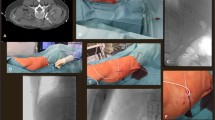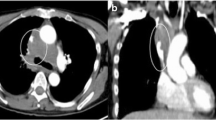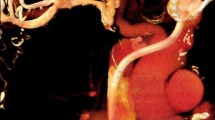Abstract
Purpose: To describe a combined procedure of repositioning and leaving in situ a central venous catheter followed by immediate percutaneous treatment of associated superior vena cava syndrome (SVCS).
Methods: Eight patients are presented who have central venous catheter-associated SVCS (n=6 Hickman catheters, n=2 Port-a-cath) caused by central vein stenosis (n=4) or concomitant thrombosis (n=4). With the use of a vascular snare introduced via the transcubital or transjugular approach, the tip of the central venous catheter could be engaged, and repositioned after deployment of a stent in the innominate or superior vena cava.
Results: In all patients it was technically feasible to reposition the central venous catheter and treat the SVCS at the same time. In one patient flipping of the Hickman catheter in its original position provoked dislocation of the released Palmaz stent, which could be positioned in the right common iliac vein.
Conclusion: Repositioning of a central venous catheter just before and after stent deployment in SVCS is technically feasible and a better alternative than preprocedural removal of the vascular access.
Similar content being viewed by others
References
Trerotola S (1996) Hemodialysis-related central venous stenosis. In: Savader SJ, Trerotola SO (eds) Venous Interventional Radiology with Clinical Perspectives. Thieme, New York, pp 274–278
Kerr HD (1990) Superior vena cava syndrome associated with a Hickman catheter. N Y State J Med 90:208–210
Richmond G, Handwerger S, Schoenfeld N, Talavera W (1992) Superior vena cava syndrome: A complication of Hickman catheter insertion in patients with the acquired immunodeficiency syndrome. N Y State J Med 92:65–66
Banalagay E, Perlmutter J, Palevsky P (1993) Central venous hemodialysis catheter-related superior vena cava syndrome. (letter) Clin Nephrol 40:59–60
Nazarian GK, Myers TV, Bjarnason H, Stackhouse DJ, Dietz CA, Hunter DW (1995) Applications of the Amplatz snare device during interventional radiologic procedures. AJR 165:673–678
Brown PW, McBride KD, Gaines PA (1994) Technical report: Hickman catheter rescue. Clin Radiol 49:891–894
Roizental M, Hartnell GG (1995) The misplaced central venous catheter: A long-loop technique for repositioning. J Vasc Interv Radiol 6:263–265
Hartnell GG, Roziental M (1995) Percutaneous transfemoral repositioning of malpositioned central venous catheters. AJR 164:1003–1006
Author information
Authors and Affiliations
Rights and permissions
About this article
Cite this article
Stockx, L., Raat, H., Donck, J. et al. Repositioning and leaving in situ the central venous catheter during percutaneous treatment of associated superior vena cava syndrome: A report of eight cases. Cardiovasc Intervent Radiol 22, 224–226 (1999). https://doi.org/10.1007/s002709900371
Issue Date:
DOI: https://doi.org/10.1007/s002709900371




